Tumor can be controlled and controlled, so half of death can be avoided
Author:Medical community Time:2022.09.03
For medical professionals for reading reference

Smoking, drinking, and obesity have become the most important carcinogenic factor
Recently, Liu Ye Dao published the "System Analysis of Global Cancer Cancer, which can be attributed to risk factors from 2010-2019 to risk factors." In 2019 ".
This analysis evaluated the results including cancer death and disability adjustment of life (DALY), including 23 types of cancer types, 34 behaviors, environment, occupations, and metabolism.
It was found that nearly half of the world's cancer death can be avoided.
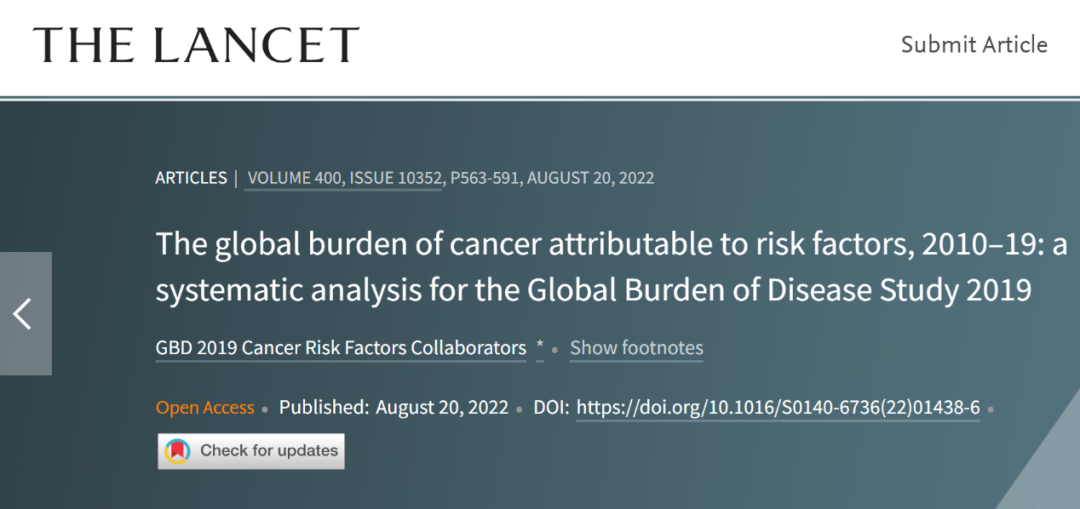
Study homepage screenshot
There are so many cancer deaths in the world to be completely guarded!
In 2019, the total number of cancer deaths caused by risk factors reached 4.45 million, accounting for 44.4%of the total number of cancer deaths. Among them, the number of men's risk is 2.88 million, and women are 1.58 million, accounting for 50.6%and 36.3%of the total number of bisexual cancer deaths, respectively.
In 2019, the total number of cancer DALY caused by all risk factors around the world was 105 million, accounting for 42%of all cancer DALY. Among them, the risk attribution of men and women is 48.0%and 34.3%of all cancers DALY DALY, respectively. Nearly half of cancer death can be avoided!
In terms of attribution of cancer DALY, the most important risk factors are:
Smoking;
Drink;
High body weight index (BMI).
Among men, only 33.9%of all cancers DALY, followed by drinking (7.4%), diet risk (5.9%), and air pollution (4%).
Smoking accounts for 10.7%of women's cancer DALY, unsafe behavior (8.2%) is the second major risk factor for women, followed by diet risk (5.1%), high BMI (4.7%), and high -altitude abdominal blood glucose ( 3.6%).
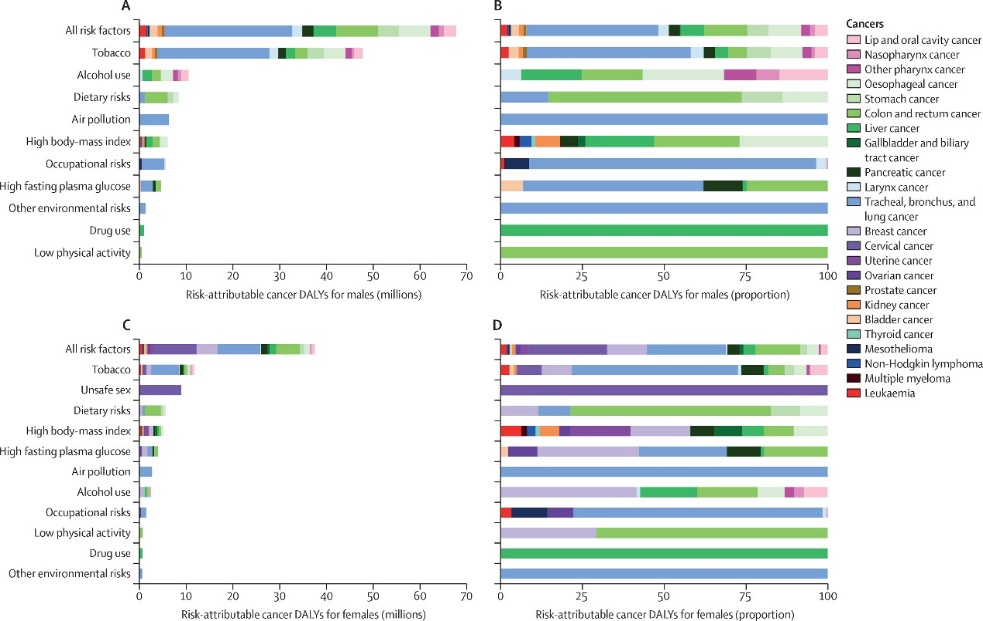
Cancer DALY caused by 11 secondary risk factors worldwide in 2019
In the ranking of cancer, lung cancer does not unexpectedly ride the dust, accounting for 36.9%of all risk attribution of cancer death. Followed by men's colorectal, esophageal cancer and gastric cancer, as well as female cervical cancer, colorectal and breast cancer.
Among the main causes of cancer death, except for the main (such as breast cancer) or only (such as cervical cancer, ovarian cancer, and uterine cancer), men do more than women due to cancer death and risk attribution due to cancer.
In 2019, the proportion of global cancer death and risk attribution of cancer deaths in high SDI countries is too high, respectively, 25.4%and 26.5%, respectively, although these countries only account for 13.1%of the global population, to some extent, cancer can be regarded as "" "Rich disease".
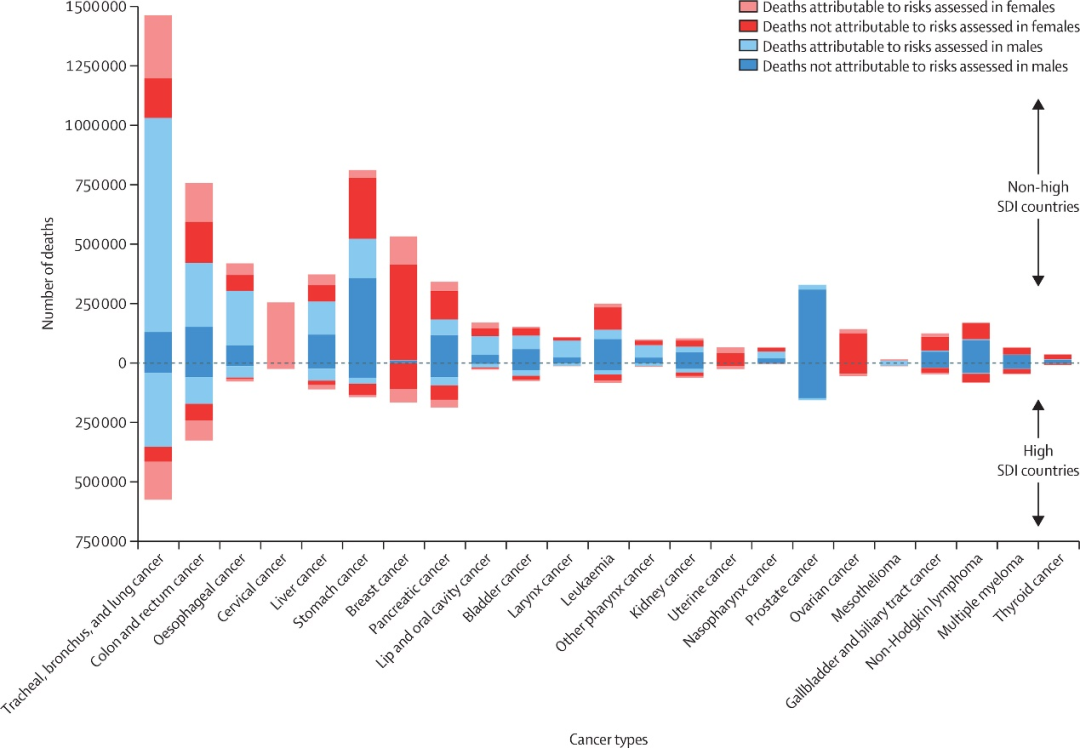
Global risk attribution of cancer in 2019 according to gender and SDI
In the analysis of all -age groups, for the same age group, behavioral risk attribution cancer DALY is usually higher than environmental and occupational risks and metabolic risk attribution cancer DALY rates, and can be attributed to the cancer DALY rate. Increase and higher. The incidence of cancer DALY in each first -level risk category increases with age.
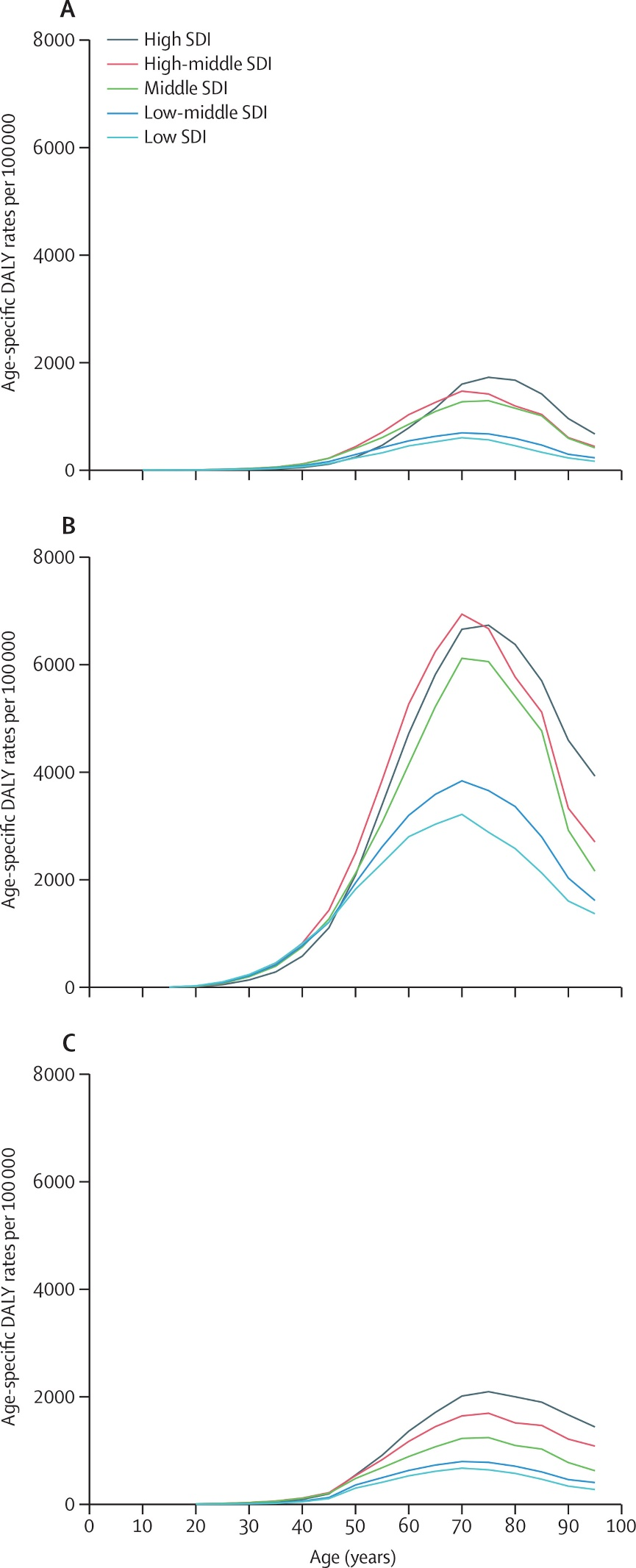
Risk attribution in 2019 is estimated to be cancer DALY, SDI, and age -specific ratio estimation
(A) Environment and occupational risk; (b) behavioral risk; (C) metabolic risk
The greatest increase in the past 10 years can change risk factors
In terms of time changes, all risk factors estimated between 2010 and 2019 have increased global cause of cancer death by 20.4%, DALY increased by 16.8%, but global age standardization can be attributed to cancer mortality rates decreased by 6.9%, DALY decreased reduction 7.8%.
在一级风险因素类别中,可归因癌症死亡和DALY增加百分比最大的是代谢风险,从2010至19年间分别增加了34.7%和33.3%,而行为风险(17.9%和14.4%)以及环境和Occupational risks (16.7%and 13.1%) are less than half as much as possible.

The percentage of global risk attribution of global risk attribution between 2010-2019 changes
Similarly, the maximum percentage of global standardization can attributed to cancer mortality and the maximum percentage of the DALY rate is also metabolic risk factor, which increased by 2.8%and 3.8%, respectively, while behavioral risk factors decreased by 8.7%and 9.6%, respectively. Decreased by 10.0%and 11.4%, respectively.
In addition, the risk attribution in various places is very different from the changes in cancer DALY and death, as well as age standardization DALY and mortality.
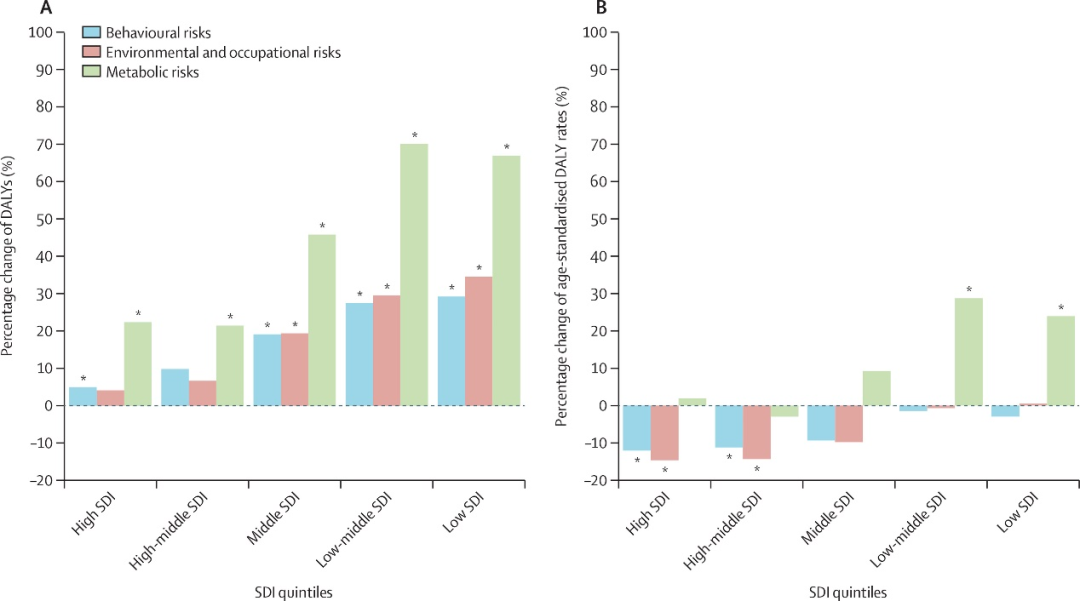
From 2010 to 2019, the risk of risk factors calculated based on the SDI five-bit digits calculations attributed the percentage of the percentage of cancer DALY and age standardization DALY
(A) Risk attribution calculated based on SDI five -bit digits is attributed to cancer DALY percentage changes;
China: Compared with the level of socioeconomic development, "fails"!
In 2019, the global standardization of cancer age that can be attributed to environmental and occupations, behaviors and metabolic risks is different from all places. The age standardization of these first -level risk factors is generally high. Central Europe, Western Europe and Eastern Europe are particularly significant. In 2019, the five regions with risk attribution to the highest risk of cancer are the highest -rate death rates of cancer.
2019 risk attribution of cancer burden of age standardization DALY Global Map
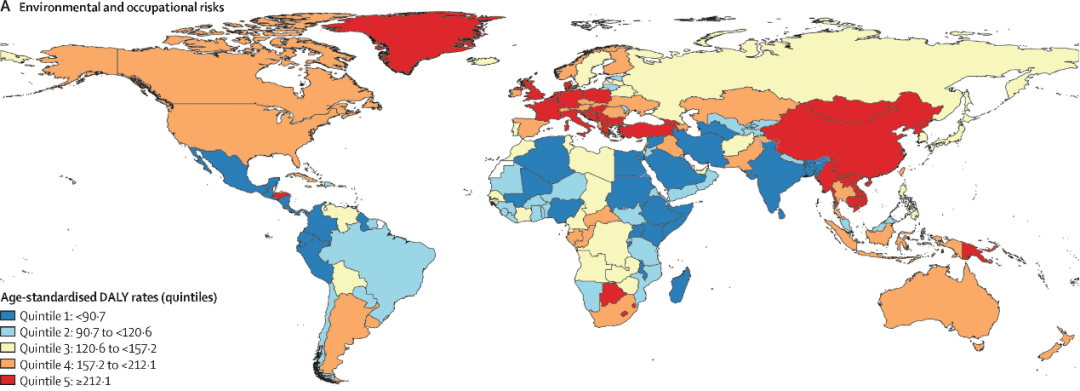

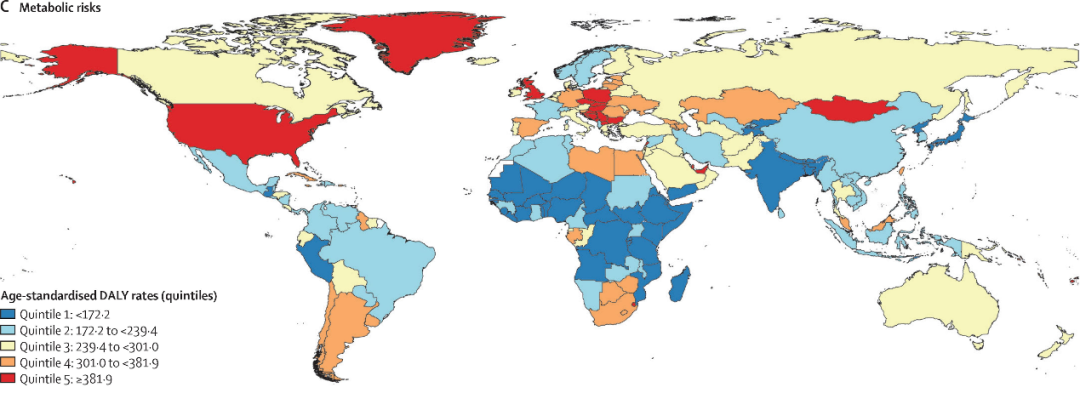
Seeing this, let's dig into the report of my country's risk attribution in this report. Overall, compared to the world, we can avoid cancer death and DALY.
By the national risk attribution of risk attribution in 2019 and percentage of DALY

In terms of changes in age -standardized cancer mortality and DALY rate, compared with global data, my country has a comprehensive leader in the control of the three major and first -level risk factors. However, compared to the high SDI teams that have been among my country in the past 10 years, especially in the control of environmental and vocational risks and behavioral risks, it has not matched the level of economic and social development.
Control the burden on cancer, you should pay attention to these 3 points in the future

First of all, nearly half of the global cancer death in 2019 can be attributed to the risk factors of research and evaluation. We can work hard, including implementing specific policies to reduce contact risk factors (such as smoking and drinking), and vaccination to prevent carcinogenic infections (including B B (including B B Hepatitis and human papilloma virus) vaccine.
But for the remaining half of the cancer, we are "unable to prevent". Therefore, the efforts to reduce the risk of cancer must be combined with a comprehensive cancer control strategy, including early diagnosis and effective treatment. "Active prevention"+"effective diagnosis and treatment" walks on both legs.
Secondly, there is a large gender difference in risk attribution to cancer burden (cancer: 34.3%of men with 48%vs female), which is concentrated in two major risk factors.
For example, due to behavioral risk factors, such as smoking (33.2%VS women 8.9%) and drinking (7.4%vs female 2.3%), the difference in cancer DALY, which may be more likely to be exposed to these behavioral risk factors than women. To.
In terms of environmental and occupational risks, Cancer DALY caused by career carcinogen (3.9%) is 3 times (1.3%) of women (3.9%), which reflects that men are more likely to be employed by women who are more risky in contact with carcinogens than women. Work.
These results may indicate that "men and women are different" in the intervention of cancer risk factors is the real "equality between men and women."
Again, risk attribution to the standardization of cancer age DALY also has gradient due to the characteristics of social population, and usually increases with the increase of SDI five points.
However, from 2010 to 2019, risk attribution to the standardization of cancer age DALY has declined in high, medium, and medium SDI countries, but has increased in low -to -middle SDI countries.
This growth mainly comes from metabolic risks, which may be the "side effect" in the development of these countries -the improvement of national development is related to the increase in obesity.
How to improve the living standards of the people and avoid the increase in cancer burden at the same time, this study may bring us some thinking.
references:
[1]GBD 2019 Cancer Risk Factors Collaborators.The global burden of cancer attributable to risk factors,2010-19:a systematic analysis for the Global Burden of Disease Study 2019.Lancet.2022 Aug 20;400(10352):563-591 .doi: 10.1016/S0140-6736 (22) 01438-6.pmid: 35988567.
[2] https://www.medscape.com/viewArticle/979461?src=#vp_2
wx_fmt = pNG "data-nickName =" medical community "data-alias =" yixuejiezazhi "data-signature =" hi, finally wait until you have a good quality, level, caring!Provide you with reliable, useful, and valuable content is our way of existence. "Data-from =" 2 "data-is_biz_ban =" 0 " /> Source: The medical tumor channel
Author: lily
School pair: Zang Hengjia
Editor: Wang Hang
- END -
Zhixi District, Yantai City: Entering the city to learn hand to create a non -heritage

Culture is a bond that consolidates spiritual power, and it is also a key point fo...
37 degrees Celsius!Continue high temperature in many places, and the State Grid people war the summer heat to protect the power ~
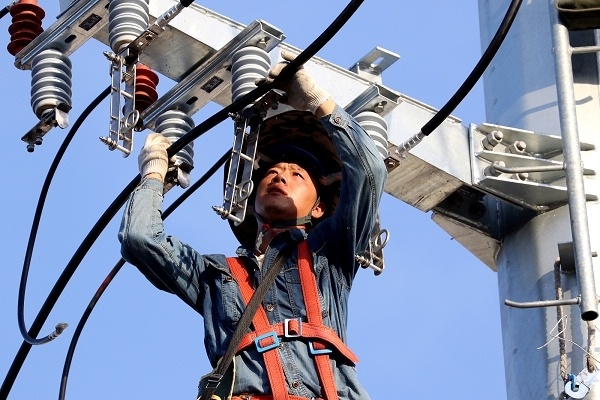
Since mid -June, high temperature weather has appeared in many places in my countr...